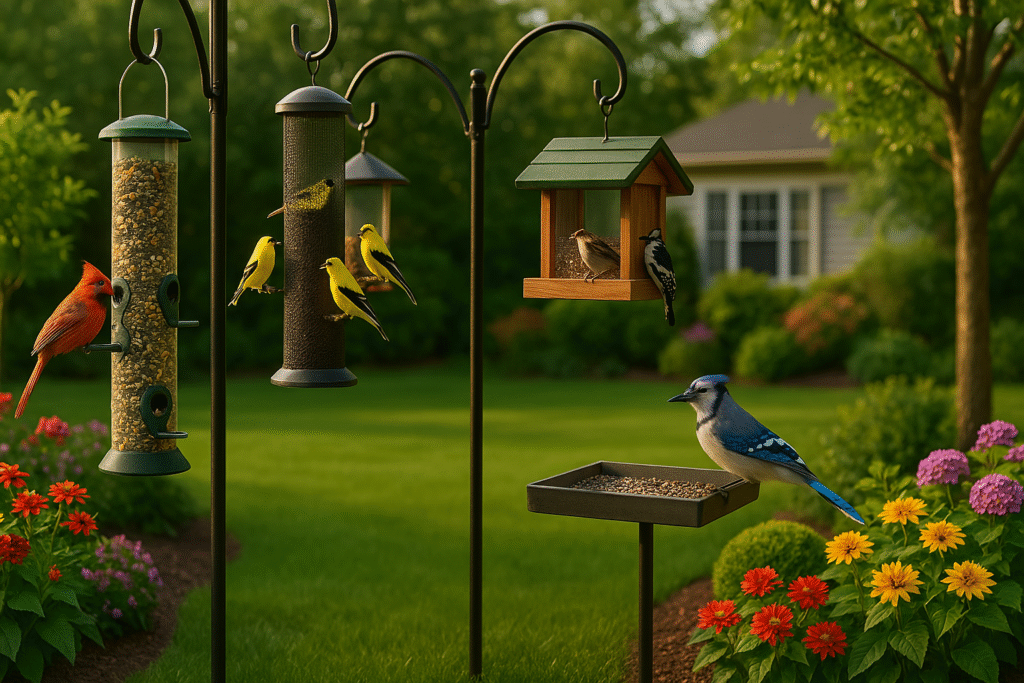Introduction: Feeder Confusion? Let’s Clear That Up

Choosing the right bird feeder isn’t just about picking something that looks good next to your patio gnome (though we respect a good lawn gnome aesthetic). It’s about attracting the birds you want to see, suiting your local weather, and keeping those feathered freeloaders happy and healthy.
Whether you’re looking to entertain the neighborhood goldfinches or make friends with a few bossy blue jays, this guide breaks down the best feeders for your needs, your environment, and your winged visitors.
Know Your Local Birds: Who’s Actually Visiting?
Before you hang up anything with seed, take a look around. Do you live in a wooded area? A suburban neighborhood? Near water? Each setting brings different species:
- Cardinals, chickadees, and titmice love bushy, wooded yards.
- Finches, sparrows, and doves thrive in more open spaces.
- Woodpeckers and nuthatches go for tree-heavy or rural areas.
- Hummingbirds? If you’ve got flowers or flowering trees, they’ll come sipping.
🛠️ Pro Tip: Use binoculars or a birding app to identify your regular guests before investing in a feeder.
Feeder Types and What They’re Best For
Here’s the birdseed buffet breakdown — no reservation required:
🐦 Tube Feeders
- Best for: Finches, chickadees, titmice, sparrows
- Use in: Almost any backyard
- Seed type: Black oil sunflower or nyjer
- Bonus: Squirrels find them trickier (unless they’re acrobats)
🐤 Platform/Tray Feeders
- Best for: Cardinals, jays, doves, grosbeaks
- Use in: Open yards with ground-feeding birds
- Seed type: Mixed blends, cracked corn
- Caution: These are open to weather and squirrels — bring snacks, they’ll be back
🐦 Hopper Feeders
- Best for: Cardinals, grosbeaks, woodpeckers
- Use in: All climates, especially cold or wet
- Seed type: Black oil sunflower, mixed
- Bonus: Sheltered from weather — a birdy B&B
🐝 Nectar Feeders
- Best for: Hummingbirds
- Use in: Warm, flowering gardens
- Nectar tip: Homemade sugar water (4:1 ratio, no red dye!)
🧈 Suet Feeders
- Best for: Woodpeckers, wrens, nuthatches
- Use in: Colder climates (it melts in heat)
- Feed type: Suet cakes with seeds or fruit
- Tip: Hang near trees for easy access
Consider the Climate: Feeder Material and Maintenance
You don’t want your feeder falling apart in the first storm. Choose materials based on your local weather:
- Wet climates: Go for metal and plastic — wood can rot or warp
- Cold areas: Use hopper or suet feeders to offer higher-energy food
- Hot zones: Choose feeders with good ventilation, especially for nectar and suet
🧽 Cleaning Reminder: Dirty feeders = sick birds. Clean at least every 2 weeks (weekly for nectar).
Placement: It’s Real Estate for Birds
Birds are picky about where they dine:
- Near cover, but not too close: Birds like quick escape routes, but too much brush invites predators.
- Away from windows: Prevent collisions — use decals or move feeders within 3 feet of windows if needed.
- Out of squirrel reach: Use baffles or squirrel-proof poles (unless you’re hosting a squirrel circus on purpose).
Match the Feed to the Feeder
Don’t make the rookie mistake of putting nyjer seed in a hopper or tossing peanuts into a tube. Match food to feeder:
| Feeder Type | Best Seed/Food Type |
|---|---|
| Tube | Nyjer, sunflower chips |
| Platform | Mixed seed, cracked corn |
| Hopper | Black oil sunflower, blends |
| Suet Cage | Suet cakes, peanut butter mix |
| Nectar | 4:1 water-to-sugar solution |
Final Word: It’s a Feeder, Not a Fort
Don’t overthink it! Start with one or two feeders, see who shows up, and build from there. The right feeder will keep your backyard buzzing with life — and give you a front-row seat to the daily birdie drama.
🛠️ Still not sure what to get? Pop by your local hardware store. (We hear the staff’s especially helpful.)